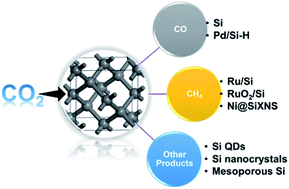The next big thing for silicon nanostructures – CO2 photocatalysis
Abstract
Silicene is a relatively new member of the growing family of two-dimensional single-element materials. Both top-down and bottom-up approaches provide access to silicene, the former via vapor deposition on a substrate and the latter via exfoliation of the layered CaSi2 precursor. Most top-down research has been concerned with understanding the various electronic, optical, magnetic, mechanical, electrical, thermal transport and gas-adsorption properties of silicene. By contrast, the focus on bottom-up silicene has primarily been on its synthesis, structure and chemical properties as they relate to its function and utility. Herein, emphasis is placed on the bottom-up strategy because of its scalability and the ease of subsequent silicene modification, with both qualities being important prerequisites for heterogeneous catalysis applications. In this context, synthetic freestanding silicene exists as single sheets or multilayer assemblies, depending on the CaSi2 exfoliation synthesis conditions. The structure of a sheet comprises three connected chair-configuration silicon 6-rings. This connectivity creates buckled sheets in which the hybridization around the unsaturated silicon atoms is sp2–sp3. By adjusting the CaSi2 exfoliation synthesis conditions, either layered silane (Si6H6) or siloxene (Si6H3(OH)3) nanosheets can be obtained. In our studies, we have explored the nucleation and growth of different transition metal nanoparticles on and within the layer spaces of these nanosheets, and explored their thermochemical and photochemical reactivity in CO2 hydrogenation reactions. An overview of these findings, related works and a new-and-optimized catalyst are provided in this article.

- This article is part of the themed collection: Luminescent silicon nanostructures


 Please wait while we load your content...
Please wait while we load your content...